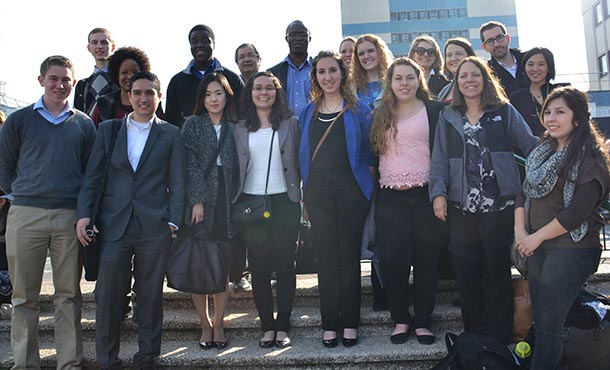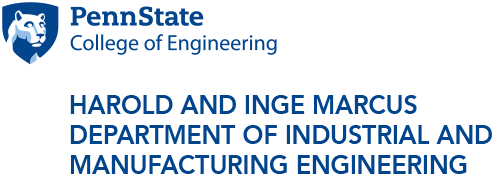
An interdisciplinary team of Penn State faculty, graduate student mentors and undergraduate students from the Harold and Inge Marcus Department of Industrial Engineering recently traveled to France to study systems engineering approaches to health care coordination. Here, the collaborative team in France poses for a group photo.
Industrial engineers visit France to study health care delivery systems
3/24/2015
UNIVERSITY PARK, Pa. — An interdisciplinary team of Penn State faculty, graduate student mentors and undergraduate students from the Harold and Inge Marcus Department of Industrial and Manufacturing Engineering recently traveled to France to study systems engineering approaches to health care coordination.
Interim Department Head Harriet Black Nembhard, director of the Center for Integrated Healthcare Delivery Systems (CIHDS), led the team. The visit was part of a collaborative effort funded by the College of Engineering’s Global Engineering Leadership Program.
During the trip, the team attended a three-day conference that provided an opportunity for them to collaborate with faculty and staff from Ecole Centrale Paris, Henri Mondor University Hospital and Saint Camille Hospital, to identify challenges and research opportunities regarding pressing health care issues.
“I have always believed that visiting new countries and being exposed to new cultures is incredibly valuable since it gives us a different perspective of the ‘small’ world we live in day-to-day,” said David Munoz, a graduate student in industrial engineering at Penn State. “This experience was extremely helpful to identify areas of opportunity in the United States and France, and how best practices could be adapted and translated to our different health care systems.”
The group’s research initiatives focus on care coordination for patients with chronic diseases such as breast cancer, diabetes, heart failure, kidney disease and skin cancer. The goals of the visit were to compare the impact of care coordination interventions in the two populations, to unify or integrate existing knowledge and to identify the structures or elements that provide the basis of potential interventions.
The group discussed the impact of health care coordination in the United States, which has a multi-payer system, and France, which has a single-payer health care system.
“Despite totally different health care reimbursement models, the challenges of engaging patients and care teams are very similar in our two countries,” said William Curry, professor of family and community medicine and public health sciences in the College of Medicine.
Topics of discussion included the potential contribution to addressing the burden of disease in the two countries based on quality adjusted life years and the contribution of disease to total health spending and its distribution, as well as statistics on health care provisions and on supportive technologies.
“Our team was enlightened to learn how French industrial engineering has led to improvements in processes of patient care that have been shown to improve patient outcomes,” said Curry. “Without alignment of health care payment models to improve care pathways, implementation of industrial engineering techniques is difficult in either country.”
Marija Jankovic, associate professor of industrial engineering at Ecole Centrale Paris, said that hearing from both engineers and health care professionals was essential for her to truly grasp the challenges in delivery systems.
“This exchange was very fruitful because only through collaborative efforts were we able to start to understand the similarities and differences in both French and U.S. systems, and eventually it allows us to see how one can nurture the other,” she said.
Penn State undergraduate industrial engineering students Robert Borochock, Jasmine Bowen, Malorie Feidner, Matthew Gorka, Judson Kibagendi and Nichole Stoner presented their research projects on care coordination models at Ecole Centrale Paris. They worked under the guidance of Lisa Korman, CIHDS assistant director and research associate; Munoz and Hyojung Kang, doctoral students in industrial engineering; and Alison Walsh, a doctoral student in nursing. They were thankful for the chance to explore the issues through the eyes of French engineering students and health care professionals to get a broader view of the challenges and the opportunities.
“It was interesting to see that several of the problems related to care coordination are shared between our countries so it’s given me more of a global perspective on ways to use our analytical and problem-solving skills to address common problems,” said Munoz.
Walsh appreciated the opportunity to view some of the challenges in healthcare from a different perspective as well.
“As nurses, we tend to approach health care from a patient-centered viewpoint so combining our mindsets with a systems engineering approach gave me a broader view of the health care systems,” she said.
Judith Hupcey, professor and associate dean for graduate education in Penn State’s College of Nursing, noted the difference in the education between nurses in the United States and France.
“We found that few French nurses receive education beyond a bachelor’s degree and that they do not have advanced practice nurses,” she said. “The nurses were surprised when I gave my presentation because they had not encountered nurses who have programs of research or major funding available to them. We had to explain that I am a doctorally prepared nurse, and that in the College of Nursing, we have many faculty members with programs of research.”
The hope for the program is that a unified approach to exploring these issues will allow students and faculty to develop further educational and research opportunities while also providing a platform for federal proposals to support applied exploration and education in health care systems engineering in both countries.
“I hope that in the future we will continue to exchange knowledge and work together in order to gain better insights into health care systems engineering and future challenges that need to be addressed,” added Jankovic.
Nembhard said her vision for the project is that it provides a platform for scoping research opportunities in a way that products greater impact on healthcare: “We can go beyond one study, one hospital, one health care system. We can proliferate our efforts quite broadly.”
“The undergraduate students on the team are sophomores and juniors who will carry this experience with them as they move throughout their other industrial engineering courses,” she added. “I want them to start thinking now about graduate school. I’m delighted that they have formed a cohesive bond.”
Following the conference, participants enjoyed a day of exploring some of the most famous landmarks in France, including the Eiffel Tower, the Louvre and the Palace of Versailles.




